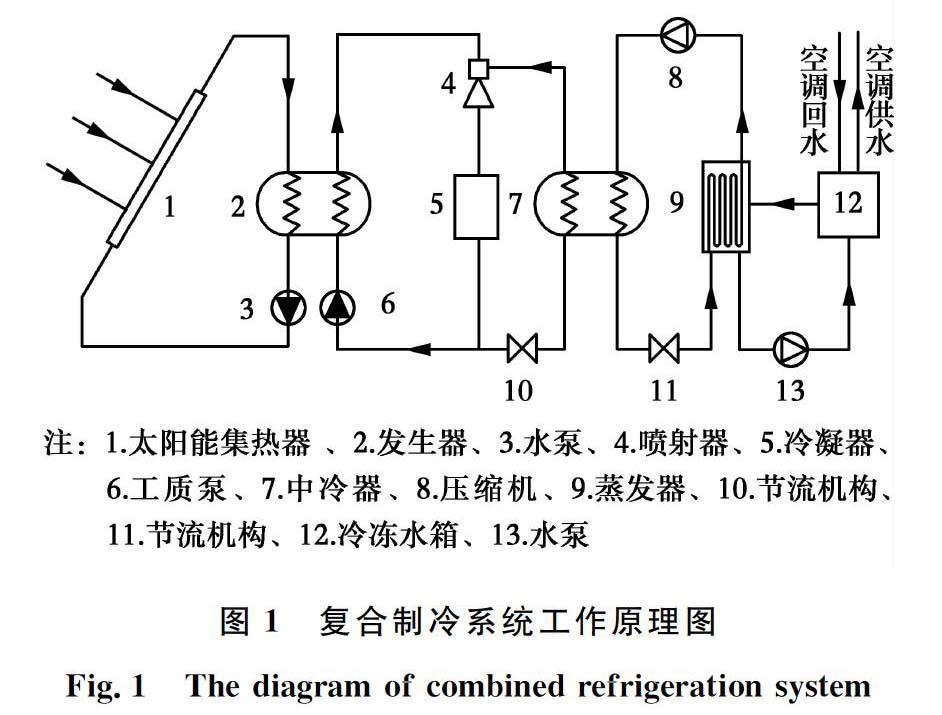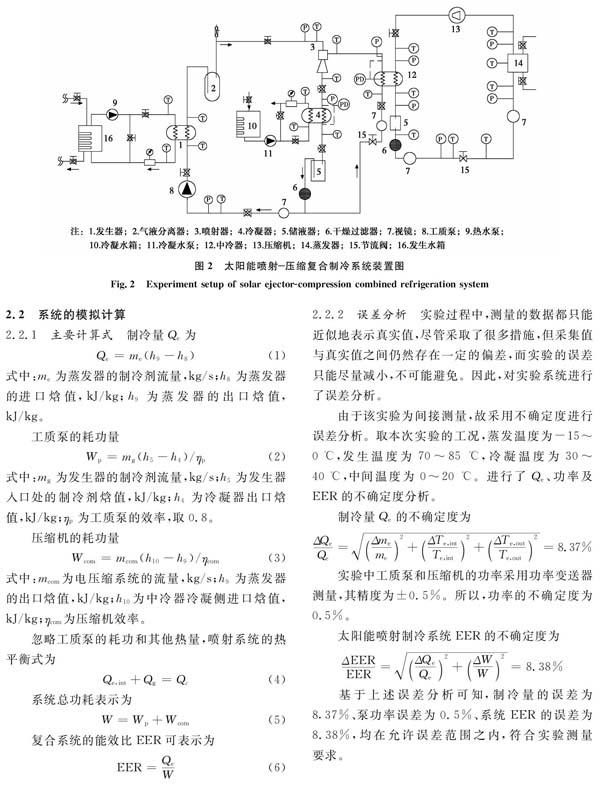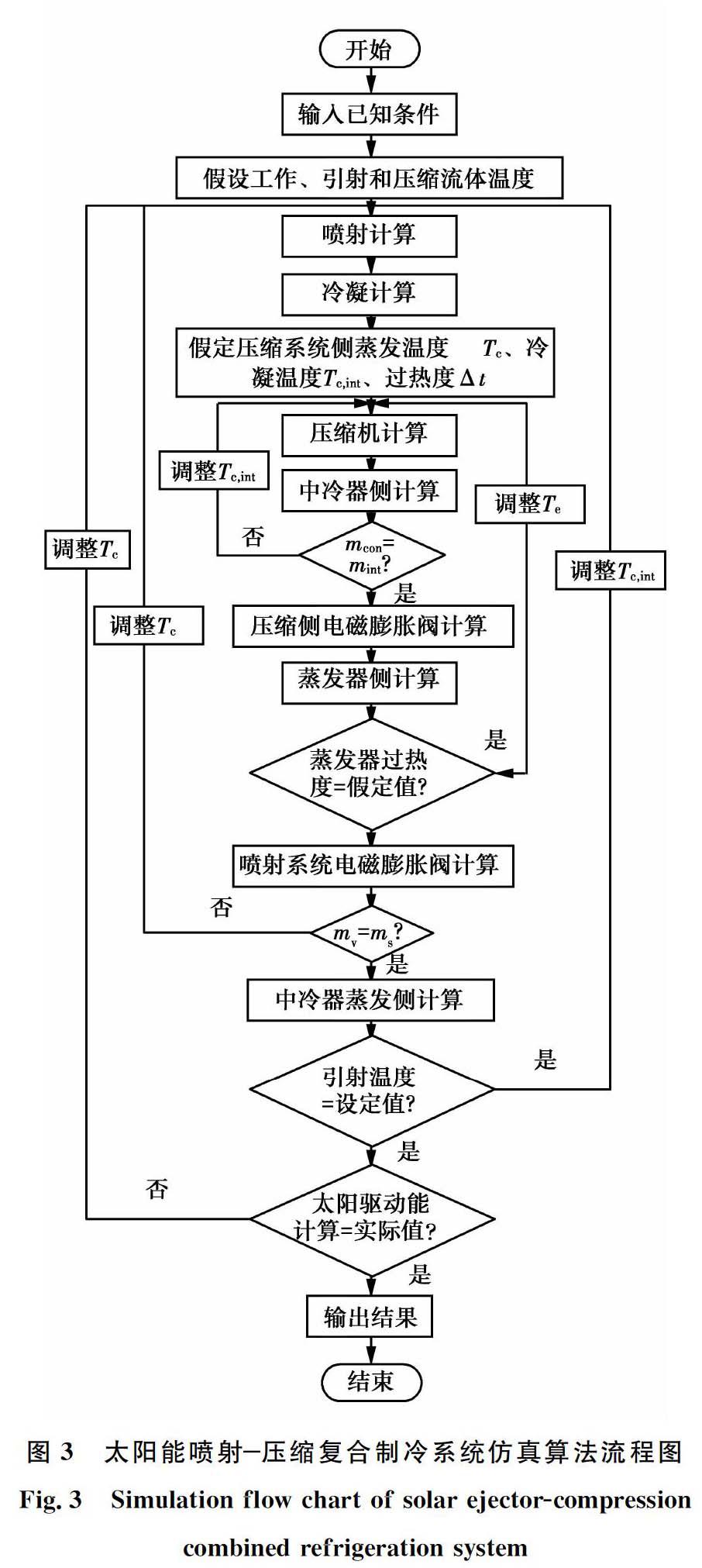太阳能喷射压缩复合制冷系统的实验及仿真
郑慧凡 陈银龙 田国记 王兴豫 范晓伟 梁耀华



摘要:建立了太阳能喷射压缩复合制冷系统的实验研究平台,基于EES软件程序进行系统稳态仿真,实验验证了仿真模拟程序的正确性,分析了不同发生温度、中间温度对系统性能的影响。研究表明,在中间温度和冷凝温度不变的情况下,随着发生温度的升高,总功率先降低后升高,系统EER先升高后降低;同时,系统COP呈先逐渐升高而后降低的趋势。在研究范围内,最优发生温度工作区域为78~80 ℃,此时,系统的总耗功量最小;最优中间温度工作区域为7~10 ℃,此时,系统制冷量达2 245 W,EER最高为3.39。
关键词:喷射压缩复合制冷;仿真;最优中间温度;最优发生温度
中图分类号:TB65
文献标志码:A 文章编号:1674-4764(2016)02-0084-06
Abstract:An experiment and simnlation of solar ejector-compression combined refrigeration system were conduced, and the results of the simulation model was verified with experimental data. The influence of the generator temperature and middle-temperature on solar ejector-compression combined refrigeration system has been studied. Research shows that:
with the increasing of generator temperature,it is found that the COP and the EER increase first and then decline, and the power consumption decreases first and then increases at the same time. In addition, it was seen that there exists the optimal generator temperature and the optimal middle-temperature,and the optimal generator temperature and middle-temperature are between 78 and 80 ℃ ,7 and 10 ℃ over the range of research conditions respectively. The minimum total power consumption can be obtained, when the optimal generator temperature are from
78 to 80 ℃,and the maximun cooling capacity and EER can reach to
2 245 W,0.34 respectively when the optimal middle-temperature and from 7 to 10 ℃.
Keywords:ejector-compression combined refrigeration system; simulation; the optimal middle-temperature; the optimal generator temperature
随着环境污染和能源危机的日益加剧,太阳能、风能等清洁能源越来越受到人们的重视,在太阳能利用技术中,太阳能喷射制冷系统以其结构简单、运动部件少等优点在制冷领域应用越来越广[1]。近年来,许多学者对其特性进行了研究,Alexis等[2]结合雅典地区的气候特点,分析了以R134a为制冷剂的太阳能喷射制冷系统的运行特性;Ersoy等[3]以R123为制冷剂,研究了太阳能喷射制冷系统在土耳其南部诸城市的逐时运行性能;Clemens等[4]以水作为制冷剂,对太阳能喷射制冷系统进行了实验研究,实验测试了当太阳辐射量逐时变化时,系统的制冷量、COP等参数随蒸发温度和冷凝温度的变化;Bogdan等[5-6]对太阳能喷射制冷系统的蓄能性能进行了数值计算和实验研究,分析了集热面积、集热效率、蓄能量等参数的关系,研究表明:蓄冷装置的设计大大提高了系统的工作稳定性和房间的热舒适度;Yu等[7]理论分析了以R134a为制冷剂的太阳能喷射制冷系统,结果表明:在发生温度为80 ℃,冷凝温度为30 ℃,蒸发温度为15 ℃时,亚临界COP为0.45,跨临界COP为0.75;Zhang等[8]建立了计算模型,模拟分析了R236fa 作为制冷剂,太阳能喷射制冷系统的运行性能,指出典型工况条件下,COP为0.413,COP0可达0.243;Chidambarama等[9]对单一和复合太阳能制冷系统进行了综述,指出蓄能系统的设计是太阳能制冷的下一个研究方向;2013年,Ali等[10]对太阳能热利用空调技术进行了全面的总结,指出太阳能空调技术未来研究重点应该致力于系统效率的提高和运行稳定性方面。
由上述文献可知,单一太阳能喷射制冷系统受太阳辐射的影响难以持续稳定的工作,其推广使用受到了较大限制。基于此,Sun等[11]提出了一种全新的喷射压缩复合系统,研究表明:与常规电压缩系统相比,相同制冷量情况下,该复合系统可以节能50%;Jorge等[12]将太阳能喷射制冷的蒸发器与压缩系统的冷凝器合二为一,提出了喷射压缩中冷器复合形式,并分析了以R134a、R142b和R114作为制冷剂时系统的综合性能;Praitoon等[13-14]研究了蒸汽压缩喷射制冷系统中冷热源温度以及喷嘴对于循环COP、压缩机压力比、制冷能力等参数的影响;Ruangtrakoon等[15]对喷射器串联级数与实际工况的关系进行了研究,指出在其他工况相同时,串联喷射器级数越高,喷射式制冷系统在低蒸发温度下效率越高。同时,冷凝器压力也会直接影响喷射器工作,当喷射器出口压力过高时,喷射器引射系数将大幅降低,影响系统工作效率;Yan等[16]对风冷情况下的喷射式制冷系统进行了理论模拟;田琦等[17-18]对太阳能喷射复合系统进行了研究。但关于喷射制冷复合制冷系统的仿真模型研究尚不多见,关于中间温度和发生温度优化运行的研究更少。基于此,本文建立太阳能喷射压缩复合制冷系统仿真模型,实验验证模型的准确性,并重点分析发生温度、中间温度等参数对系统性能的影响。
1 复合系统
太阳能喷射压缩复合系统工作原理如图1所示。该复合系统主要包括3个子系统:太阳能集热子系统、喷射压缩复合制冷子系统和空调冷冻水子系统。其中,太阳能集热子系统主要由太阳能集热器、发生器和水泵组成,为喷射制冷系统提供热源;喷射压缩复合制冷子系统主要由喷射器、冷凝器、工质泵、中冷器、压缩机、蒸发器、和节流阀组成;空调冷冻水系统主要包括蒸发器、冷冻水箱和水泵。
2 系统实验装置和仿真算法设计
2.1 系统实验装置
复合系统的实验装置如图2所示。在发生器、喷射器、蒸发器和冷凝器的进出口分别设置压力变送器,精度为±0.25%;温度测量采用PT100铂电阻温度计,测量误差为±0. 2 ℃,分别布置在各个设备的制冷剂侧和水侧的进出口处;流量测量采用电磁流量计,精度为0.5%级;功率测量采用型号为XJ93系列的功率变送器,精度为±0.5%。所有测量参数均通过数据采集系统自动采集。有关实验平台更详细的内容参考文献[19]。
3 系统性能分析
3.1 模型验证
为了验证模型的准确性,图4给出了实验值和模拟计算EER值的对比,其中蒸发温度取-5 ℃,中间温度取10 ℃,冷凝温度取35 ℃。由图可知,模拟计算值与实验值的变化趋势相似,该模型可以进行复合系统性能预测。两者最大误差为18.7%,平均误差为14.9%。模拟值和实验值出现差异的主要原因在于仿真程序进行了简化和假定,且内部蒸发器、中冷器等模型均采取了稳态计算模型。
图8给出了当系统冷凝温度为35 ℃,发生温度为80 ℃时,系统制冷量随中间温度变化的趋势。由图可知,系统制冷量随中间温度的升高逐渐减小,究其原因为电压缩系统的冷凝温度升高,致使制冷能力下降;同时,随着蒸发温度的升高,系统的制冷量逐渐增大。当中间温度为5~20 ℃,蒸发温度为-15、-10、-5 ℃时,制冷量的最大值分别为1 545 、1 797 、2 245 W,最小值为998 、1 206 、1 325 W。
4 结 论
本文对太阳能喷射压缩复合制冷系统工作原理进行了分析,建立了复合系统稳态仿真模型,并实验验证了模型的正确性。计算并分析了发生温度、中间温度对系统性能的影响。主要研究结论如下:
1)复合系统的EER均高于单一喷射系统和单一电压缩系统,一定研究工况下,复合系统、单一喷射与单一压缩3个系统的EER最大值分别为3.39、2.86和2.61。
2)在中间温度和冷凝温度不变的情况下,随着发生温度的升高,EER先升高后降低,总功率则先降低后升高;同时,COP呈先逐渐升高而后降低的趋势。研究表明,当中间温度为10 ℃,冷凝温度为35 ℃,蒸发温度分别为-5、-10和-15 ℃,发生温度最优工作范围为78~80 ℃,此时,系统的总耗功量最小,EER达到最大,COP分别为0.38、0.37、0.35。
3)中间温度对复合系统整体性能的影响显著。EER随中间温度升高先上升后下降,制冷量随中间温度的升高逐渐减小。当冷凝温度为35 ℃,发生温度为80 ℃,蒸发温度分别为-5、-10和-15 ℃时,存在最优的中间温度范围为7~10 ℃,此时系统EER达到最高,其对应的EER最大值分别为 3.39、2.86、2.61,且制冷量最高可达2 245 W。
参考文献:
[1] DORANTES R, ESTRADA C A, PILATOWSKY I. Mathematical simulation of a solar ejector-compression refrigeration system [J]. Applied Thermal Energy, 1996, 16(8): 669-675.
[2] ALEXIS G K, KARAYIANNIS E K. A solar ejector cooling system using refrigerant R134a in the Athens area [J]. Renewable Energy, 2005, 30(9): 1457-1469.
[3] ERSOY K H, YALCIN S, YAPICI R. Performance of a solar ejector cooling-system in the southern region of Turkey [J]. Applied Energy,2007, 84(9): 971-983.
[4] CLEMENS P, AHMED H, ALIB H. Experimental study on the performance of a solar driven steam jet ejector chiller[J]. Energy Conversion and Management, 2008, 49(11): 3318-3325.
[5] BOGDAN M, DIACONU S V, ARMANDO C O. Numerical simulation of a solar-assisted ejector air conditioning system with cold storage[J]. Energy, 2011, 36(2): 1280-1291.
[6] BOGDAN M D. Energy analysis of a solar-assisted ejector cycle air conditioning system with low temperature thermal energy storage[J]. Renewable Energy, 2012, 37(1): 266-276.
[7] YU J L, LI Y Z. A theoretical study of a novel regenerative ejector refrigeration cycle [J]. International Journal of Refrigeration, 2007, 30(3): 464-470.
[8] ZHANG B, SONG X T,LV J S, et al. Study on the key ejector structures of the waste heat-driven ejector air conditioning system with R236fa as working fluid [J]. Energy and Buildings, 2012, 49(1): 209-215.
[9] CHIDAMBARAM L A, RAMANA A S, KAMARAJ G. Review of solar cooling methods and thermal storage options [J]. Renewable and Sustainable Energy Reviews, 2011, 15(6): 3220-3228.
[10] AL A, HWANG Y, RADERMACHER R. Review of solar thermal air conditioning technologies[J]. International Journal of Refrigeration, 2013, 36(11): 1-19.
[11] SUN D W. Solar powered combined ejector-vapour compression cycle for air conditioning and refrigeration[J]. Energy Conversation Management, 1997, 38(5): 479-491.
[12] JORGE I H, RUBEN J, DORANTE R. The behaviour of a hybrid compressor and ejector refrigeration system with refrigerants 134a and 142b [J]. Applied Thermal Engineering, 2004, 24(13): 1765-1783.
[13] PRAITOON C, SOMCHAI W. Effect of throat diameters of the ejector on the performance of the refrigeration cycle using a two-phase ejector as an expansion device[J]. International Journal of Refrigeration, 2007, 30(4): 601-608.
[14] PRAITOON C, SOMCHAI W. Experimental study on R134a refrigeration system using a two-phase ejector as an expansion device [J]. Applied Thermal Engineering, 2008, 28(5-6): 467-477.
[15] RUANGTRAKOON N, PHORNRATANA S A, SRIVEERAKUL T. Experimental studies of a steam jet refrigeration cycle: Effect of the primary nozzle geometries to system performance[J]. Experimental Thermal and Fluid Science, 2011, 35(4): 676-683.
[16] YAN J, CAI W J. Area ratio effects to the performance of air-cooled ejector refrigeration cycle with R134a refrigerant [J]. Energy Conversion and Management, 2012, 53(1): 240-246.
[17] 田琦. 太阳能喷射与压缩一体化制冷系统的研究[D]. 天津: 天津大学, 2005.
TIAN Q. Researoh on the solar powered united ejector-vapour compression refrigeration system [D]. Tianjin: Tianjin Unversity,2005.(in Chinese)
[18] 田琦, 王美萍. 太阳能喷射与压缩制冷系统的集蓄热构建系统的性能研究[J]. 中北大学学报(自然科学版), 2012, 33(4): 466- 470.
TIAN Q, WANG M P. Performance study of heat component on solar energy ejecting and compressing refrigeration system [J]. Journal of North University of China(Natural Science Edition), 2012, 33(4): 466-470. (in Chinese)
[19] 梁耀华. 太阳能喷射压缩复合制冷系统仿真计算[D]. 郑州: 中原工学院, 2014.
LIANG Y H. The simulation calculation of the solar ejector-compression combined refrigeration system [D]. Zhengzhou:Zhongyuan Universify of Technology,2014.(in Chinese)
(编辑 郭 飞)

